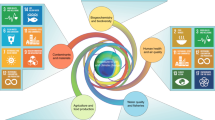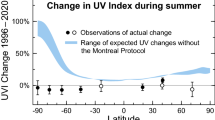Abstract
Temporal and geographical variabilities in the future “world expected” UV environment are compared with the “world avoided”, which would have occurred without the Montreal Protocol on Substances That Deplete the Ozone Layer and its subsequent amendments and adjustments. Based on calculations of clear-sky UV irradiances, the effects of the Montreal Protocol have been hugely beneficial to avoid the health risks, such as skin cancer, which are associated with high UV, while there is only a small increase in health risks, such as vitamin D deficiency, that are associated with low UV. However, interactions with climate change may lead to changes in cloud and albedo, and possibly behavioural changes that could also be important.
Similar content being viewed by others
References
G. J. M. Velders, S. O. Andersen, J. S. Daniel, D. W. Fahey and M. McFarland, The importance of the Montreal Protocol in protecting climate, Proc. Natl. Acad. Sci. U. S. A., 2007, 104, 4814–4819.
WMO, Scientific Assessment of Ozone Depletion: 2010, Global Ozone Research and Monitoring Project - Report No. 52, Geneva, 2011.
UNEP, Environmental effects of ozone depletion and its interactions with climate change: 2010 assessment, Photochem. Photobiol. Sci., 2011, 10, 174, DOI: 10.1039/c0pp90041a.
P. A. Newman, L. D. Oman, A. R. Douglass, E. L. Fleming, S. M. Frith, M. M. Hurwitz, S. R. Kawa, C. H. Jackman, N. A. Krotkov, E. R. Nash, J. E. Nielsen, S. Pawson, R. S. Stolarski and G. J. M. Velders, What would have happened to the ozone layer if chlorofluorocarbons (CFCs) had not been regulated?, Atmos. Chem. Phys., 2009, 9, 2113–2128.
H. Slaper, G. J. M. Velders, J. S. Daniel, F. R. de Gruijl and J. C. van der Leun, Estimates of ozone depletion and skin cancer incidence to examine the Vienna convention achievements, Nature, 1996, 384, 256–258.
UNEP, Environmental effects of ozone depletion: 1994 assessment, UNEP Report No., Nairobi, p. 110. Available from: http://sedac.ciesin.org/ozone/UNEP/UNEP94toc.html.
K. E. Trenberth and J. T. Fasullo, Global warming due to increasing absorbed solar radiation, Geophys. Res. Lett., 2009, 36, DOI: 10.1029/2009GL037527.
S. Pawson, R. S. Stolarski, A. R. Douglass, P. A. Newman, J. E. Nielsen, S. M. Frith and M. L. Gupta, Goddard Earth Observing System chemistry-climate model simulations of stratospheric ozonetemperature coupling between 1950 and 2005, J. Geophys. Res., 2008, 113, DOI: 10.1029/2007JD009511.
W. D. Collins, C. M. Bitz, M. L. Blackmon, G. B. Bonan, C. S. Bretherton, J. A. Carton, P. Chang, S. C. Doney, J. J. Hack, T. B. Henderson, J. T. Kiehl, W. G. Large, D. S. McKenna, B. D. Santer and R. D. Smith, The Community Climate System Model Version 3 (CCSM3), J. Clim., 2006, 19, 2122–2143.
WMO, Scientific Assessment of Ozone Depletion: 2002, Global Ozone Research and Monitoring Project - Report No. 47, Geneva, 2003.
L. D. Oman, D. Plummer, D. W. Waugh, J. Austin, J. Scinocca, A. R. Douglass, R. J. Salawitch, T. Canty, H. Akiyoshi, S. Bekki, P. Braesicke, N. Butchart, M. Chipperfield, D. Cugnet, S. Dhomse, V. Eyring, S. Frith, S. C. Hardiman, D. Kinnison, J. F. Lamarque, E. Mancini, M. Marchand, M. Michou, O. Morgenstern, T. Nakamura, J. E. Nielsen, D. Olivie, G. Pitari, J. Pyle, E. Rozanov, T. G. Shepherd, K. Shibata, R. S. Stolarski, H. Teyssedre, W. Tian and Y. Yamashita, Multi-model assessment of the factors driving the ozone evolution over the 21st century, J. Geophys. Res., 2010, 115, D24306, DOI: 10.1029/2010JD014362.
V. Eyring, N. Butchart, D. W. Waugh, H. Akiyoshi, J. Austin, S. Bekki, G. E. Bodeker, B. A. Boville, C. Brühl, M. P. Chipperfield, E. Cordero, M. Dameris, M. Deushi, V. E. Fioletov, S. M. Frith, R. R. Garcia, A. Gettelman, M. A. Giorgetta, V. Grewe, L. Jourdain, D. E. Kinnison, E. Mancini, E. Manzini, M. Marchand, D. R. Marsh, T. Nagashima, P. A. Newman, J. E. Nielsen, S. Pawson, G. Pitari, D. A. Plummer, E. Rozanov, M. Schraner, T. G. Shepherd, K. Shibata, R. S. Stolarski, H. Struthers, W. Tian and M. Yoshiki, Assessment of temperature, trace species, and ozone in chemistry-climate model simulations of the recent past, J. Geophys. Res., 2006, 111.
V. Eyring, D. W. Waugh, G. E. Bodeker, E. Cordero, H. Akiyoshi, J. Austin, S. R. Beagley, B. A. Boville, P. Braesicke, C. Brühl, N. Butchart, M. P. Chipperfield, M. Dameris, R. Deckert, M. Deushi, S. M. Frith, R. R. Garcia, A. Gettelman, M. A. Giorgetta, D. E. Kinnison, E. Mancini, E. Manzini, D. R. Marsh, S. Matthes, T. Nagashima, P. A. Newman, J. E. Nielsen, S. Pawson, G. Pitari, D. A. Plummer, E. Rozanov, M. Schraner, J. F. Scinocca, K. Semeniuk, T. G. Shepherd, K. Shibata, B. Steil, R. S. Stolarski, W. Tian and M. Yoshiki, Multimodel projections of ozone recovery in the 21st century, J. Geophys. Res., 2007, 112.
SPARC CCMVal, SPARC Report on the Evaluation of Chemistry-Climate Models, in SPARC Report No. 5 WCRP-132 WMO/TD-No. 1526, ed. V. Eyring, T. G. Shepherd and D. W. Waugh, 2010.
V. Eyring, I. Cionni, G. E. Bodeker, A. J. Charlton-Perez, D. E. Kinnison, J. F. Scinocca, D. W. Waugh, H. Akiyoshi, S. Bekki, M. P. Chipperfield, M. Dameris, S. Dhomse, S. M. Frith, H. Garny, A. Gettelman, A. Kubin, U. Langematz, E. Mancini, M. Marchand, T. Nakamura, L. D. Oman, S. Pawson, G. Pitari, D. A. Plummer, E. Rozanov, T. G. Shepherd, K. Shibata, W. Tian, P. Braesicke, S. C. Hardiman, J. F. Lamarque, O. Morgenstern, D. Smale, J. A. Pyle and Y. Yamashita, Multi-model assessment of ozone return dates and ozone recovery in CCMVal-2 models, Atmos. Chem. Phys., 2010, 10, 9451–9472.
J. Austin and R. J. Wilson, Sensitivity of polar ozone to sea surface temperatures and halogen amounts, J. Geophys. Res., 2010, 115, DOI: 10.1029/2009JD013292.
A. F. McKinlay and B. L. Diffey, A reference action spectrum for ultra-violet induced erythema in human skin, in Human Exposure to Ultraviolet Radiation: Risks and Regulations, ed. W. F. Passchier and B. F. M. Bosnajakovic, Elsevier, Amsterdam, 1987, pp. 83–87.
S. Madronich and S. Flocke, Theoretical estimation of biologically effective UV radiation at the earth’s surface, in Solar Ultraviolet Radiation. NATO Series I: Advanced Study Institute, ed. C. S. Zerefos and A. F. Bais, Vol. 52, Springer, Berlin, 1995, pp. 23–48.
K. Stamnes and R. A. Swanson, A new look at the discrete ordinate method for radiative transfer calculations in anisotropically scattering atmospheres, J. Atmos. Sci., 1981, 38, 387–399.
J. Zeng, R. McKenzie, K. Stamnes, M. Wineland and J. Rosen, Measured UV spectra compared with discrete ordinate method simulations, J. Geophys. Res., 1994, 99, 23019–23030.
R. L. McKenzie, P. V. Johnston, D. Smale, B. Bodhaine and S. Madronich, Altitude effects on UV spectral irradiance deduced from measurements at Lauder, New Zealand and at Mauna Loa Observatory, Hawaii, J. Geophys. Res., 2001, 106, 22845–22860.
R. L. McKenzie and J. B. Liley, Balancing Risks and Benefits of UV radiation, in UV Radiation in Global Change: Measurements Modeling and Effects on Ecosystems, ed. W. Gao, D. L. Schmoldt and J. R. Slusser, Tsinghua University Press and Springer-Verlag, Beijing/New York, 2010, pp. 21–47.
R. L. McKenzie, G. E. Bodeker, G. Scott and J. Slusser, Geographical differences in erythemally-weighted UV measured at mid-latitude USDA sites, Photochem. Photobiol. Sci., 2006, 5, 343–352.
R. S. Stolarski and S. M. Frith, Search for evidence of trend slowdown in the long-term TOMS/SBUV total ozone data record: the importance of instrument drift uncertainty, Atmos. Chem. Phys., 2006, 6, 4057–4065.
WHO, Global solar UV Index: A practical guide, World Health Organisation (WHO), World Meteorological Organisation (WMO), United Nations Environment Program (UNEP) and International Commission on Non-Ionising Radiation Protection (ICNRP), Geneva, 2002.
G. Bernhard, C. R. Booth and J. C. Ehramjian, Climatology of ultraviolet radiation at high latitudes derived from measurements of the national Science Foundation’s spectral irradiance monitoring network, in UV Radiation in Global Change: Measurements Modeling and Effects on Ecosystems, ed. W. Gao, D. L. Schmoldt and J. R. Slusser, Tsinghua University Press and Springer-Verlag, Beijing/New York, 2010, p. 544.
A. Zittermann, Vitamin D in preventive medicine: are we ignoring the evidence?, Br. J. Nutr., 2007, 89, 552–572.
F. Wu, T. Staykova, A. Horne, J. Clearwater, R. Ames, B. Mason, B. Orr-Walker, G. Gamble, M. Scott and I. Reid, Efficacy of an oral, 10-day course of high-dose calciferol in correcting vitamin D deficiency, N. Z. Med. J., 2003, 116, http://www.nzma.org.nz/journal/116-1179/536/.
J. Livesey, P. Elder, J. Ellis, R. McKenzie, B. Liley and C. Florkowski, Seasonal variation in vitamin D levels in the Canterbury population in relation to available UV radiation, N. Z. Med. J., 2007, 120, http://www.nzma.org.nz/journal/120-1262/2733/.
O. Engelsen, M. Brustad, L. Aksnes and E. Lund, Daily duration of vitamin D synthesis in human skin with relation to Latitude, Total Ozone, Altitude, ground cover, aerosols and cloud thickness, Photochem. Photobiol., 2005, 81, 1287–1290.
R. L. McKenzie, J. B. Liley and L. O. Björn, UV Radiation: Balancing Risks and Benefits, Photochem. Photobiol., 2009, 85, 88–98.
A. R. Webb, L. Kline and M. F. Holick, Influence of season and latitude on the cutaneous synthesis of vitamin D3: Exposure to winter sunlight in Boston and Edmonton will not promote vitamin D3 synthesis in human skin, J. Clin. Endocrinol. Metab., 1988, 67, 373–378.
C. Y. Wright, A. I. Reeder, G. E. Bodeker, A. Gray and B. Cox, Solar UVR exposure, concurrent activities and sun-protective practices among primary schoolchildren, Photochem. Photobiol., 2007, 83, 749–758.
P. Knuschke, I. Unverricht, G. Ott and M. Jansen, Personenbezogene messung der UV-Exposition von Arbeitnehmern im freien, Bundesanstalt fur Arbeitsschutz und Arbeitsmedian (BAUA) Report No., Dortmund/Berlin/Dresden, p. 195. Available from: http://www.baua.de/cae/servlet/contentblob/699494/publicationFile/46848/F1777.pdf.
A. Kylling, A. Dahlback and B. Mayer, The effect of clouds and surface albedo on UV irradiances at a high latitude site, Geophys. Res. Lett., 2000, 27, 1411–1414.
A. Kylling, T. Persen, B. Mayer and T. Svenøe, Determination of an effective spectral surface albedo from ground-based global and direct UV irradiance measurements, J. Geophys. Res., 2000, 105, 4949–4959.
M. Degünther, R. Meerkötter, A. Albold and G. Seckmeyer, Case study of the influence of inhomogeneous surface albedo on UV irradiance, Geophys. Res. Lett., 1998, 25, 3587–3590.
Author information
Authors and Affiliations
Rights and permissions
About this article
Cite this article
Newman, P.A., McKenzie, R. UV impacts avoided by the Montreal Protocol. Photochem Photobiol Sci 10, 1152–1160 (2011). https://doi.org/10.1039/c0pp00387e
Received:
Accepted:
Published:
Issue Date:
DOI: https://doi.org/10.1039/c0pp00387e




